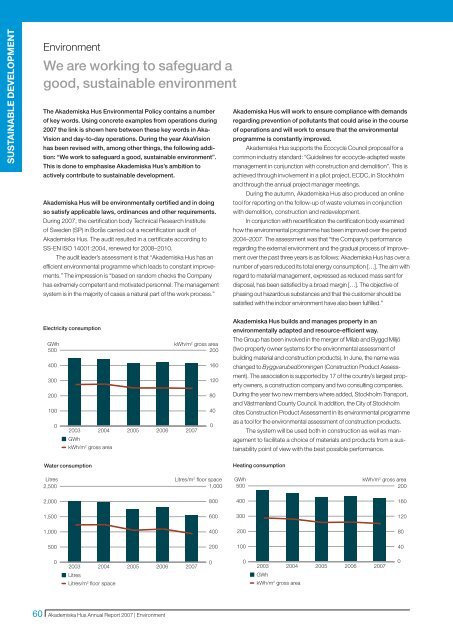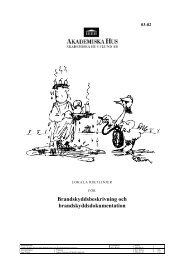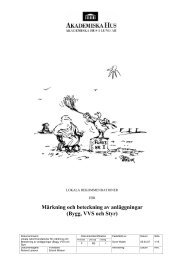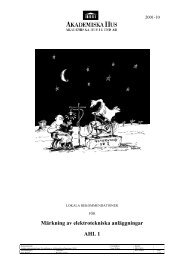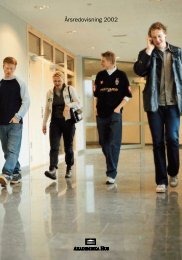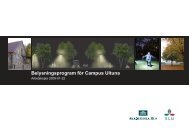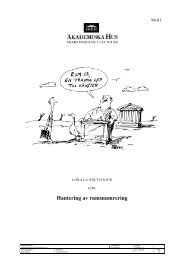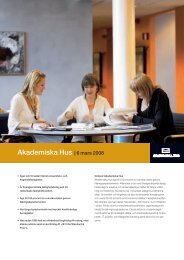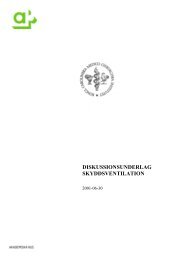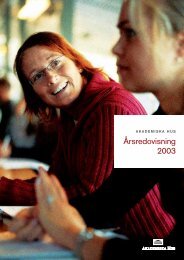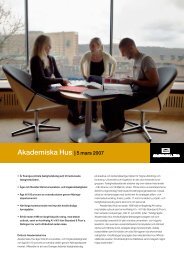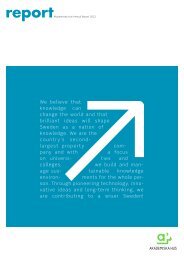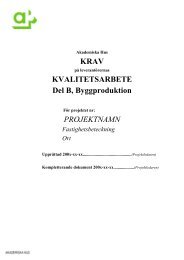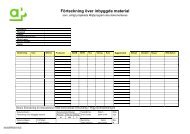SUSTAINABLE DEVELOPMENTEnvironmentWe are working to safeguard agood, sustainable environmentThe <strong>Akademiska</strong> <strong>Hus</strong> Environmental Policy contains a numberof key words. Using concrete examples from operations during2007 the link is shown here between these key words in Aka-Vision and day-to-day operations. During the year AkaVisionhas been revised with, among other things, the following addition:“We work to safeguard a good, sustainable environment”.This is done to emphasise <strong>Akademiska</strong> <strong>Hus</strong>’s ambition toactively contribute to sustainable development.<strong>Akademiska</strong> <strong>Hus</strong> will be environmentally certified and in doingso satisfy applicable laws, ordinances and other requirements.During 2007, the certification body Technical Research Instituteof Sweden (SP) in Borås carried out a recertification audit of<strong>Akademiska</strong> <strong>Hus</strong>. The audit resulted in a certificate according toSS-EN ISO 14001:2004, renewed for 2008–2010.The audit leader’s assessment is that “<strong>Akademiska</strong> <strong>Hus</strong> has anefficient environmental programme which leads to constant improvements.”The impression is “based on random checks the Companyhas extremely competent and motivated personnel. The managementsystem is in the majority of cases a natural part of the work process.”<strong>Akademiska</strong> <strong>Hus</strong> will work to ensure compliance with demandsregarding prevention of pollutants that could arise in the courseof operations and will work to ensure that the environmentalprogramme is constantly improved.<strong>Akademiska</strong> <strong>Hus</strong> supports the Ecocycle Council proposal for acommon industry standard: “Guidelines for ecocycle-adapted wastemanagement in conjunction with construction and demolition”. This isachieved through involvement in a pilot project, ECDC, in Stockholmand through the annual project manager meetings.During the autumn, <strong>Akademiska</strong> <strong>Hus</strong> also produced an onlinetool for reporting on the follow-up of waste volumes in conjunctionwith demolition, construction and redevelopment.In conjunction with recertification the certification body examinedhow the environmental programme has been improved over the period2004–2007. The assessment was that “the Company’s performanceregarding the external environment and the gradual process of improvementover the past three years is as follows: <strong>Akademiska</strong> <strong>Hus</strong> has over anumber of years reduced its total energy consumption […]. The aim withregard to material management, expressed as reduced mass sent fordisposal, has been satisfied by a broad margin […]. The objective ofphasing out hazardous substances and that the customer should besatisfied with the indoor environment have also been fulfilled.”Electricity consumptionGWh50040030020010002003 2004GWhkWh/m 2 gross area20052006kWh/m 2 gross area200160120804002007<strong>Akademiska</strong> <strong>Hus</strong> builds and manages property in anenvironmentally adapted and resource-efficient way.The Group has been involved in the merger of Milab and Byggd Miljö(two property owner systems for the environmental assessment ofbuilding material and construction products). In June, the name waschanged to Byggvarubedömningen (Construction Product Assessment).The association is supported by 17 of the country’s largest propertyowners, a construction company and two consulting companies.During the year two new members where added, Stockholm Transport,and Västmanland County Council. In addition, the City of Stockholmcites Construction Product Assessment in its environmental programmeas a tool for the environmental assessment of construction products.The system will be used both in construction as well as managementto facilitate a choice of materials and products from a sustainabilitypoint of view with the best possible performance.Water consumptionHeating consumptionLitres2,500Litres/m 2 floor space1,000GWh500kWh/m 2 gross area2002,0008004001601,5006003001201,000400200805002001004002003 2004LitresLitres/m 2 floor space200520062007002003 2004GWhkWh/m 2 gross area200520062007060 <strong>Akademiska</strong> <strong>Hus</strong> <strong>Annual</strong> <strong>Report</strong> 2007 | Environment
<strong>Akademiska</strong> <strong>Hus</strong> is working to ensure that similar environmentalcare is demonstrated by customers, suppliers and other partnersto ensure that it has an impact throughout the whole of theGroup’s operations.<strong>Akademiska</strong> <strong>Hus</strong> runs different activities together with customers tocreate a common view regarding key environmental issues. Environmentalgroups and different networks often exist on the local level.An example of this is the <strong>Akademiska</strong> <strong>Hus</strong> environmental collaboration‘Sustainable Campus’ along with Chalmers University of Technologyand Chalmersfastigheter AB (CFAB). Collaboration has up tonow resulted in a common energy objective. Another activity whichhas been run is the common carbon dioxide inventory covering,among other things, CO 2emissions from energy and transport.Through environmental collaboration between Chalmers, CFAB and<strong>Akademiska</strong> <strong>Hus</strong>, environmental seminars have been run for severalyears following different themes. The theme for 2007 was lightingand was run three times at Chalmers and at Göteborg University.<strong>Akademiska</strong> <strong>Hus</strong> assumes responsibility for ensuring that consultantsand contractors work actively with its important environmentalaspects through a prequalification procedure in respect ofareas such as quality, environment and working environment issues.<strong>Akademiska</strong> <strong>Hus</strong> makes improving energy efficiency and thedevelopment of alternative energy production a high priority.During 2007 yet another energy store for heating and cooling wasbrought into use, this time in Karlstad. The ground store is made up of35 boreholes which generate a saving of approximately 1,000 MWh,equivalent to a 40-tonne reduction in the emission of CO 2equivalents.The total volume of CO2 as energy turnover within <strong>Akademiska</strong><strong>Hus</strong> buildings, including operating power, gave rise in 2007 (basedon the 2006 outcome reduced by two per cent) to: heating (426GWH) = approximately 34,100 tonnes, and electricity (410 GWh) =approximately 16,400 tonnes.During 2006, test bores were made to evaluate the potential foraquifer storage for the production of cooling and heating at <strong>Akademiska</strong><strong>Hus</strong> properties in Kristianstad. The work during 2007 iscontinuing, among other things with a legal process to secure awater judgment that will hopefully materialise in spring 2008. Negotiationshave also taken place with the municipal energy company.<strong>Akademiska</strong> <strong>Hus</strong> endeavours to find the most efficient energysolution for each property to the benefit of both customers and<strong>Akademiska</strong> <strong>Hus</strong>.Also during 2007 a large number of energy surveys were carried out inthe property holdings. These have led to a whole series of measures,including improved climate shells, supplementary insulation, replacementwindows, reconstruction of ventilation units, heat recycling,energy savings in flue cupboards, new control equipment, adjustmentcontrol times, replacement of light fittings, movement detectors forboth lighting and ventilation in group rooms, classrooms and conferenceareas, frequency control of ventilation units etc.The Group plays an active part in the work being conducted bythe National Board of Housing, Building and Planning to produceproposals for energy declarations. <strong>Akademiska</strong> <strong>Hus</strong> has commissionedan external energy consultant to work during 2008 on anenergy declaration of the Group’s approximately 1,000 buildings.<strong>Akademiska</strong> <strong>Hus</strong> will, through its high level of in-house expertise,be on the front line in the development and use of modern,effective technology with a good environmental profile that supportsconstruction and management and in doing so ultimatelyour customers’ operations.Several of the regional companies have during the year shown Al Gore’sfilm ‘An Inconvenient Truth’ internally to raise the employees’ insight andawareness regarding a sustainable society. Stockholm and Gothenburghave run environmental training programmes for their personnel.Several regional companies installed solar cells during the year.In total, 1,600 square metres have been installed at a total cost ofaround SEK 13 million. Government grants covered 70 per cent ofthe investment. The energy outcome has been calculated at160,000 kWh electricity per year. Profitability is still far from good andthe installations are being made for technical support reasons, goodwilland to get to know the technology.We are working to safeguard a good, sustainable ecologicalenvironment<strong>Akademiska</strong> <strong>Hus</strong> is playing an active role in the industry’s developmentof a sustainable society, among other things by taking part inthe Bygga-Bo dialogue, the Ecocycle Council, the Building ContractorsEnvironmental, Technical and Quality Group and the SwedishArchitects Environmental and Technology Committee.Electricity Electricity Heating Heating WaterkWh/m 2 floor space kWh/m 2 gross area kWh/m 2 floor space kWh/m 2 gross area Litres/m 2 floor spaceRegion 2005 2006 2007 2005 2006 2007 2005 2006 2007 2005 2006 2007 2005 2006 2007South 125 130 124 98 102 97 124 117 114 97 92 89 339 337 267West 123 125 126 94 96 97 108 111 108 80 85 83 356 434 383East 128 126 121 103 102 96 106 102 105 85 83 83 457 423 352Uppsala 161 156 161 122 118 122 191 194 180 144 147 136 504 496 432Stockholm 115 121 120 90 93 91 131 138 137 103 106 104 436 463 379North 121 118 116 98 95 94 117 114 111 94 92 90 402 406 415Total 128 129 128 100 100 99 132 134 130 103 104 100 418 435 373<strong>Akademiska</strong> <strong>Hus</strong> <strong>Annual</strong> <strong>Report</strong> 2007 | Environment 61
- Page 6 and 7:
Review of the yearAkademiska Hus 20
- Page 8 and 9:
Statement by the PresidentIncreased
- Page 10 and 11:
Business concept, visions and objec
- Page 12 and 13:
MARKETRental and property marketGoo
- Page 14 and 15: MARKETAkademiska Hus marketHigher e
- Page 16 and 17: MARKETResearch Bill 2008In internat
- Page 18 and 19: MARKETCompetitorsLocal players the
- Page 20 and 21: MARKETProperty specification, North
- Page 23 and 24: 1613 6 24 2912171142962122932464751
- Page 25 and 26: EASTERN REGION (ÖST)Major efforts
- Page 27 and 28: ((KYRKBYNE6E20GOTHENBURGSA-FÄRJEST
- Page 29 and 30: LLUNDPLANTAGELYCKANHELGONAGÅRDEN3S
- Page 31 and 32: At the Ingvar Kamprad Design Centre
- Page 33 and 34: could benefit from proximity to the
- Page 35 and 36: of energy system and form of energy
- Page 37 and 38: difficult to influence. In the Ultu
- Page 40 and 41: OPERATIONSProperty valuationSlight
- Page 42: OPERATIONSlation of the rental paym
- Page 45 and 46: Operating costsOperating costs, a s
- Page 47 and 48: Maintenance costsStable maintenance
- Page 49 and 50: Comments on the Five-year summary1.
- Page 51 and 52: Regions and GroupKey figuresKey fig
- Page 53 and 54: Average rentable floor space, regio
- Page 55 and 56: Interest-bearing net loan debt, inc
- Page 57 and 58: Construction projectsNew constructi
- Page 59 and 60: By drawing up good documents for co
- Page 61 and 62: Akademiska Hus - a partner in the d
- Page 63: SustainabilityAkademiska Hus’s am
- Page 67 and 68: EmployeesInvestment in employee dev
- Page 69 and 70: Group level, on the regional level
- Page 71 and 72: Group corporate governance reportTh
- Page 73 and 74: Remuneration and other terms and co
- Page 75 and 76: Board and auditorsBOARDEva-Britt Gu
- Page 77 and 78: Financial Report 73-10473Swedish Na
- Page 79 and 80: Income StatementsGroupIFRSParent Co
- Page 81 and 82: Balance SheetsGroupIFRSParent Compa
- Page 83 and 84: Cash Flow StatementsGroupIFRSParent
- Page 85 and 86: Note 3, cont’d .comprises rental
- Page 87 and 88: Note 3, cont’d .fair value. Chang
- Page 89 and 90: 6 Categorised operating costsFuncti
- Page 91 and 92: Note 13, cont’d .Payments to the
- Page 93 and 94: Note 17, cont’d.17 TaxesThe follo
- Page 95 and 96: Cost of capital and direct yield re
- Page 97 and 98: Note 24, cont’d.The table below s
- Page 99 and 100: Note 32, cont’d.Borrowing can be
- Page 101 and 102: Note 33, cont’d.The retirement pe
- Page 103 and 104: Note 37, cont’d.Due date structur
- Page 105 and 106: 39 Pledged assetsGroupIFRSParent Co
- Page 107 and 108: Audit ReportTo the annual meeting o
- Page 109 and 110: AddressesGROUP HEAD OFFICEAkademisk


